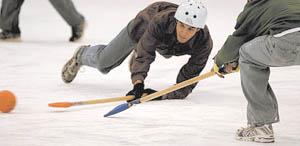
Looking across North Carolina’s only sheet of Olympic-sized ice, students gracefully stormed across the IcePlex rink donning sneakers, jeans and sweatpants.
But one lone contestant for broomball — what some participants consider the most vicious sport since dodge ball — took one for the team and came ready for battle in khaki shorts.
“He’s wearing shorts! Nobody plays broomball in shorts … he’s going to get hurt,” said Caroline Benson, a sophomore in animal science and director of the InterResidence Council’s broomball event. “No wait, maybe he’s smart.”
While looking on at her residents battling it out on the ice, she shakes her head in disbelief.
“Who wears shorts on the ice?”
But as the single figure can attest, running around anywhere — including on the ice — works up quite a sweat.
Although broomball is a low-maintenance sport, originating in Canada in 1909, to its participants, it is without question more athletic than the skeleton and curling events seen in this year’s Winter Olympics.
“It’s a real sport,” said Don Baumgartner, a graduate student in higher education and administration, and advisor to IRC. “It’s like field hockey, but on ice.”
Broomball, is a very participant-friendly sport, allowing as many competitors as can fit on the ice safely.
“Broomball is easier, cheaper and more social [than most sports]. More people are on the ice, so not as many sit and watch,” said Jennifer Andras, senior in agricultural business management and camp coordinator for the IcePlex.
Athletes are divided into teams, and each receives, not an actual broom, but a stick with an embellished end that looks like a flattened garden hoe, and wear sneakers instead of ice skates.
“Since it’s broken off into teams, I could see sororities partaking in broomball, or maybe a sorority-fraternity event,” said Andras.
Several balls are on the ice at one time, and the key, just as in lacrosse, rugby, field and ice hockey, is to score in your opponent’s net.
“If you have a helmet, stick and shoes, you’re ready to go,” said Andras.
Competitive, regulated broomball is played with only six players on each team, consisting of three forwards, two defensemen and a goalie with only one ball in play.
While the sport boasts international tournaments in ice hockey hotbeds such as Canada and Russia, and is played in over 14 countries, the sport is virtually unknown throughout North Carolina.
To publicize for the IRC event, “we gave flyers to all the RAs, advertised on the boards in Talley, sent out updates on our listserv and chalked all over campus,” said Benson.
Although it was held from 10:30 p.m. to 12:30 a.m. on a Friday, the event was a huge success, Benson said.
“It’s really a popular event, there’s a 60-person limit and we fill up every time,” said Benson. “It brings residents out in full force.”
This is the second year of the broomball event.
“This is cool to get this many kids out on a Friday night without being at a party,” Baumgartner said.
But broomball itself seems to be a party all on its own. Although it costs $350 to rent the ice from the IcePlex, IRC covers 100 percent of the costs, making it a free event to students.
“We rent out the entire rink, [the IcePlex gives] us the equipment, and we bring our own music,” said Benson.
Benson said they even had their community service chair, a practicing DJ, make mix tapes for the event.
The sport itself can be enticing because of its tendency to have a violent nature.
“It’s not too violent, but people do get checked,” said Benson. “Playing with multiple balls, no one has total control of their movement. It’s like organized chaos.”
The sport isn’t a typical boys’ club. In fact, the first athletes on the ice Friday were females, and the first to take a fall.
“There’s not many times you can run on the ice without getting arrested at an NHL game,” said Baumgartner. “Eighty percent of the people out there are not from the IRC but are part of [the University’s] general population.”
The IRC will be hosting several more upcoming events, including “48 hours of madness” beginning March 17.